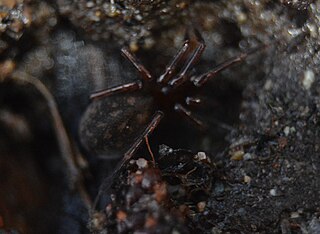
Agelenopsis, commonly known as the American grass spiders, is a genus of funnel weavers first described by C.G. Giebel in 1869. They weave sheet webs that have a funnel shelter on one edge. The web is not sticky, but these spiders make up for that shortcoming by running very rapidly. The larger specimens can grow to about 19 mm in body length. They may be recognized by the arrangement of their eight eyes into three rows. The top row has two eyes, the middle row has four eyes, and the bottom row has two eyes. They have two prominent hind spinnerets, somewhat indistinct bands on their legs, and two dark bands running down either side of the cephalothorax.

Aculepeira is a genus of orb-weaver spiders first described by R. V. Chamberlin & Wilton Ivie in 1942.

Enoplognatha is a genus of comb-footed spiders that was first described by P. Pavesi in 1880. They have both a large colulus and a subspherical abdomen. Males usually have enlarged chelicerae. It is considered a senior synonym of Symopagia.

Microlinyphia is a genus of dwarf spiders that was first described by U. Gerhardt in 1928.
Ceratinella is a genus of dwarf spiders that was first described by James Henry Emerton in 1882. They are very similar to both Ceraticelus and Idionella, and the taxonomy of these spiders may change.

Walckenaeria is a genus of dwarf spiders that was first described by John Blackwall in 1833. It is a senior synonym of Paragonatium, as well as Wideria, Cornicularia, Prosopotheca, Tigellinus, and Trachynella.

Erigone is a genus of dwarf spiders that was first described by Jean Victoire Audouin in 1826. They are carnivorous, preying on small insects such as psylla and flies. One of the distinctive characters for this genus is the presence of teeth bordering the carapace.

Agroeca is a genus of liocranid sac spiders that was first described by Niklas Westring in 1861.

Dictyna is a genus of cribellate araneomorph spiders in the family Dictynidae, and was first described by Carl Jakob Sundevall in 1833.

Cybaeus is a genus of araneomorph spiders in the family Cybaeidae, first described by Ludwig Carl Christian Koch in 1868. It is found in America, Europe, Japan, Korea and China. Females of different species are difficult to distinguish, especially in North America. Images of males that include pedipalps are the easiest to determine species.

Bathyphantes is a genus of dwarf spiders that was first described by Anton Menge in 1866.

Agyneta is a genus of dwarf spiders that was first described by J. E. Hull in 1911.
Scotinotylus is a genus of sheet weavers that was first described by Eugène Louis Simon in 1884.

Robertus is a genus of comb-footed spiders that was first described by Octavius Pickard-Cambridge in 1879. It is considered a senior synonym of Garritus.

Emblyna is a genus of cribellate araneomorph spiders in the family Dictynidae, and was first described by R. V. Chamberlin in 1948.
Diplocentria is a genus of dwarf spiders that was first described by J. E. Hull in 1911.

Dismodicus is a genus of dwarf spiders that was first described by Eugène Louis Simon in 1884.
Hybauchenidium is a genus of dwarf spiders that was first described by Å. Holm in 1973.

Hypomma is a genus of dwarf spiders that was first described by David B. Hirst in 1886.
Oreonetides is a genus of dwarf spiders that was first described by Embrik Strand in 1901.















